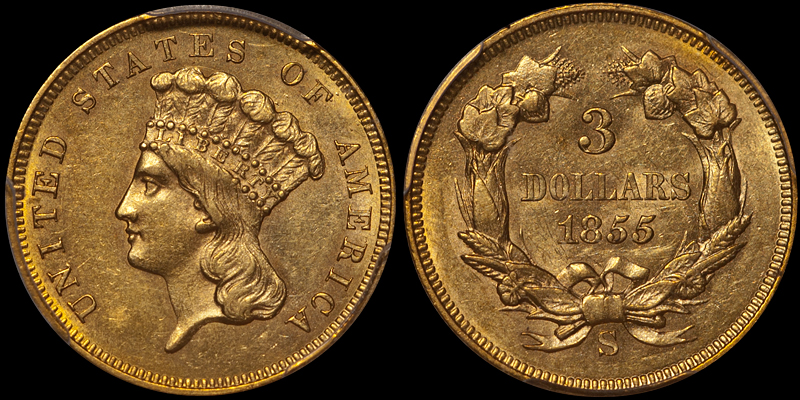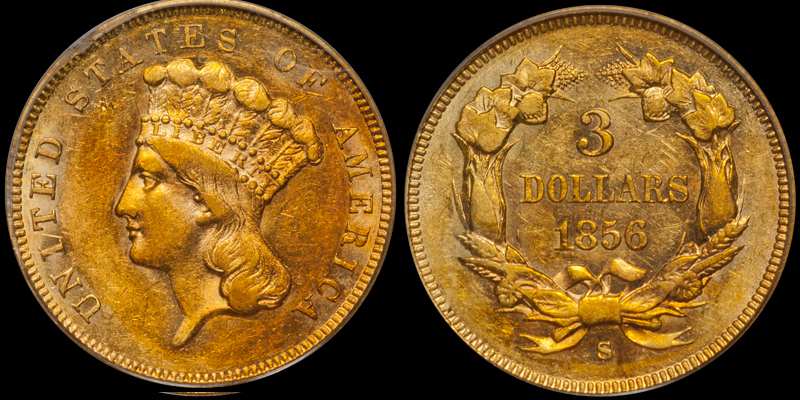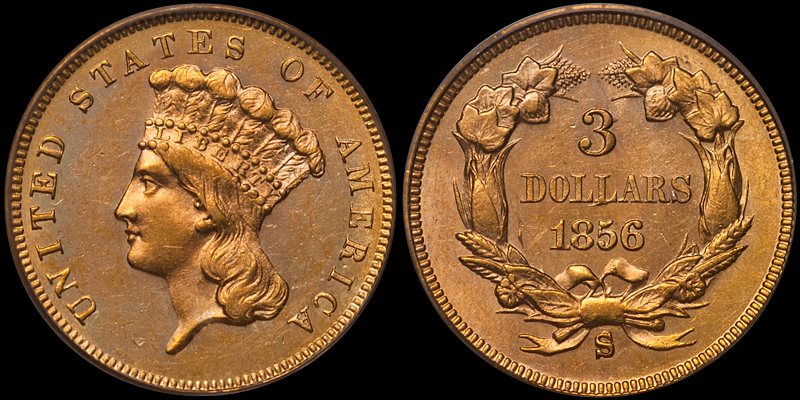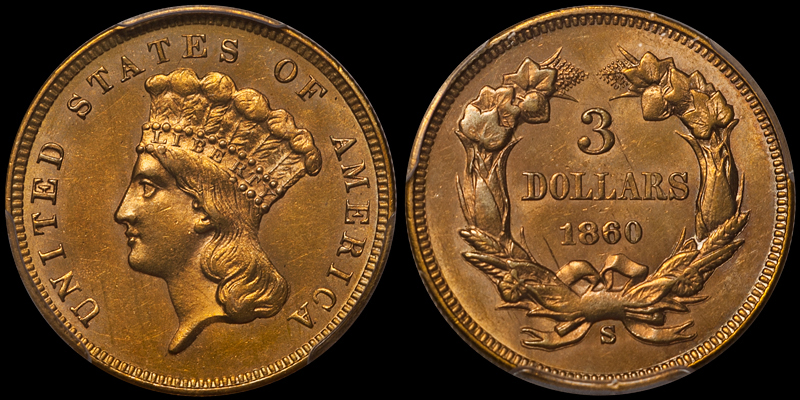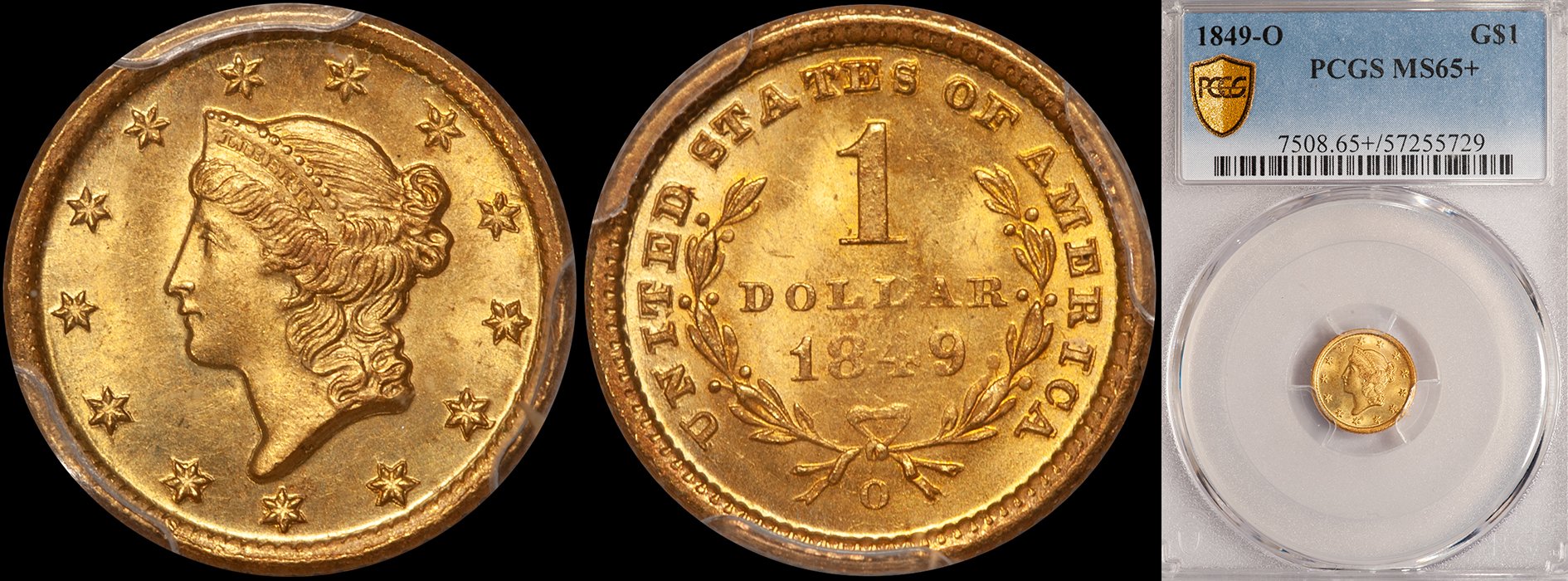Gold Coinage of the San Francisco Mint, Part Three: Three Dollar Gold Pieces, 1855-1870
/NOTE: This article was edited for content on September 23rd, 2019.
Just five Three Dollar gold pieces were made at the San Francisco mint and this includes one issue—the 1870-S—which is unique. This is an easy set to complete although all San Francisco Threes are rare in higher grades.
Let’s take a quick look at the four regular issues from this mint and rank them in order of overall rarity (the total known in all grades) and in high grade rarity (in this case MS60 and finer):
Now let’s look at each of these four dates and conclude with my thoughts on the 1870-S.
1855-S
Until recently, I ranked the 1855-S as the rarest San Francisco three dollar. However, enough of these have been located in recent years that I now rank the 1855-S as the second rarest after the 1860-S. It is still the rarest date in high grades and it remains very rare in Uncirculated.
1855-S $3.00 PCGS AU58 CAC
There were 6,600 struck, and this date appears to have seen use in local commerce as numerous examples exist in grades as low as Very Fine. The 1855-S becomes hard to locate in properly graded AU55, and it is rare in AU58. In Uncirculated, this is a very rare issue with no more than three to five known. The single finest at PCGS is the MS62+ Great Lakes/Pogue coin which brought $55,225 in 2016. An NGC MS63 set a record price for the date when it realized $64,625 in the Heritage 2017 ANA auction. The finest known is the Bass Reference Collection example which grades MS64 or so; it is currently unencapsulated. A single Proof exists as well.
1855-S $3.00 PCGS MS61
This date is almost always seen with enhanced surfaces, and examples with natural color and choice surfaces are much harder to locate than most collectors realize. The strike and luster tend to be good while the natural color is a pale to medium orange-gold.
The 1855-S was not impacted by finds from either of the S.S. Central America salvages, and there have been no examples of this date located in overseas hoards. I believe this date will remain rare in higher grades and it is likely to continue to have multiple levels of demand as it is sought by specialists and collectors who appreciate it its first-year-of-issue status.
Current values for this date are around $8,000-10,000 for an average quality PCGS AU55, and $15,000-20,000 for an AU58. These levels represent good value only if the coin in question is nice.
1856-S
The 1856-S is the second most available branch mint Three Dollar after the 1854-O and it is far and away the most available from San Francisco both in terms of its overall and high grade rarity. The finest known are three coins graded MS64 by PCGS. Surprisingly, no higher grade examples of this date were found in the S.S. Central America salvage.
1856-S $3.00 PCGS AU55 CAC, ex SSCA
Three varieties are known and these are as follows:
Medium S mintmark: Very common with about 80% of the known survivors
Small S mintmark: Scarce with about 15% of the known survivors
Large S mintmark: Rare with about 5% of the known survivors
1856-S $3.00 PCGS MS62
The 1856-S is a well-made issue which is sharply struck and which shows nice frosty luster. The natural color is a rich yellow-gold with a smaller number a more orange-gold in hue. It is reasonably easy to locate this date with unmarked surfaces and decent color, so the collector should be patient as a nice piece will come up for sale. An attractive AU55 is a good, affordable option for many collectors and such a coin should cost in the $3,000-4,000 range. A properly graded AU58 will cost $5,000-7,000, while an Uncirculated 1856-S should be available in the $15,000-20,000 range.
1857-S
The 1857-S is a bit more available than the 1855-S. As with the 1855-S, this date is seen in lower grades, proving that it saw circulation in the Western economy. It is more available than the 1855-S in the highest circulated grades, but the vast majority of the coins graded AU55 and AU58 have been stripped and are not choice.
1857-S $3.00 PCGS AU50 CAC
Until the discovery of six Uncirculated pieces in the second SSCA recovery, the 1857-S was extremely rare in Uncirculated with just two or three known, the finest being the Great Lakes/Pogue coin which realized $76,375 in early 2016. An amazing PCGS MS67 was located and it is by a clear margin, the single finest branch mint Three Dollar of any date.
1857-S $3.00 NGC EF40 CAC
The 1857-S is another well-struck issue which has good luster and which can be located with clean surfaces. Most have been processed and nice, original AU55 and AU58 pieces are much harder to locate than their seemingly high PCGS population figures would suggest.
In my opinion, nice collector grade pieces are undervalued as they can be located in the $2,500-3,000 range. An AU55 should cost around $5,500-6,000, while an AU58 will cost $12,500-15,000, but it will require considerable patience as these are not readily available.
1860-S
Only 7,000 examples of this date were produced and around 4-5% of these are known to exist with most showing considerable wear. The 1860-S is scarce in the lower to middle AU grades, and properly graded AU55 to AU58 coins are very scarce. In Uncirculated, there are likely no more than three to five known with the second finest likely the Bass II: 672 coin which is now owned by D.L. Hansen. The Eliasberg: 285 coin, which grades MS64 or finer, was purchased by Harry Bass and it is still in his reference set of Three Dollar gold pieces. It is clearlry the finest known.
1860-S $3.00 PCGS MS62
1860-S $3.00 NGC VF30 CAC
This issue often shows weakness on the lowest curls and on the bow knot. The luster is not as pronounced as on the earlier San Francisco issues and it is grainier in texture. The natural color is a rich orange-gold but very few exist with original color. I regard the 1860-S as a real appearance rarity and this is backed-up by the CAC population which shows just one coin approved in AU55, two in AU58 and none finer.
If you are able to locate a nice EF example in the $2,500-3,000, this is a no-brainer: buy it without hesitation. A nice AU55 will run around $7,500, while an AU58 is going to be hard to locate and expensive with a price tag in the $15,000-20,000 range.
1870-S
The 1870-S is one of the very few regular issue United States gold coins which is unequivocally unique. The only known example is the Bass/Eliasberg/Woodin coin which is currently on display at the ANA Museum in Colorado Springs. The coin is not especially nice as it shows signs of having been used in jewelry. It also has the numerals 893 scratched into the reverse field.
1870-S $3.00 courtesy of Coinfacts/Bowers & Merena
What would this coin sell for if it were made available to collectors? It sold for $687,500 at the Eliasberg Sale in October 1982; the exact same price as the excessively rare 1822 half eagle. Today, the 1822 is easily a $5,000,000-6,000,000 coin; possibly more. But the Eliasberg 1822 is a nice coin from an aesthetic standpoint and it is part of a series which is actively collected by date. I believe the 1870-S would bring less, and the sales record which I consider most relevant is the 1854-S half eagle.
There are three known 1854-S half eagles with only two of them collectible: the Pogue/Eliasberg coin (graded AU58 by PCGS and absolutely exceptional, in my opinion), and an NGC EF45 which surfaced last year and which sold for $2,160,000. This coin had some condition issues and there were unanswered questions about its provenance. Had the coin been a little nicer and had its origin story been more transparent, it could have easily brought $3,000,000-4,000,000.
The 1870-S is likely worth some at the midway point between the 1854-S half eagle and the 1822 half eagle.
The next article in this multi-part series will focus on No Motto Liberty Head half eagles from San Francisco. If you are interested in assembling a specialized collection of San Francisco gold coins, please contact Doug Winter by phone at (214) 675-9897 or via email at (214) 675-9897.



